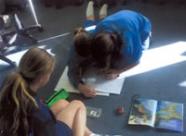Using Māori traditional stories in technology
The technology learning area fitting within the school local curriculum
In this school-wide technology unit, students illustrated the concept of transformation by creating their own short video adaptations of Māori traditional stories. The unit involved over 180 students. It illustrates ideas within the nature of technology and technological knowledge strands while enhancing skills in materials, and designing and developing digital outcomes. The project ran for nine weeks with students having two lessons per week.
Technology HOD Kim Henry explains that Northcross Intermediate's goal is for all students at the school to achieve an enduring understanding based on a single concept from the curriculum for each term. The technology department then adapts this concept to ideas within the framework of the technology learning area to continue that understanding.
"The concept for this term was transformation and within that there are enduring understandings. The one we focussed on for that term was transformation means change, and change leads to a new state. The ideas within the technology learning area we chose to fit this understanding were technology is intervention by design and technology affects us, and we affect technology. We have a unit plan that the students can see and we make them record the key stages, but really it's up to them to work their own way and morph their way through it rather than getting to a certain point by a certain time."
This snapshot is a good example of local curriculum design, assessment for learning and building cultural capability.
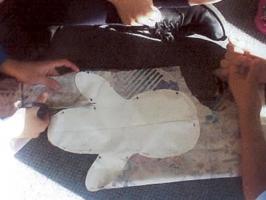
Cutting shapes with scissors.
Understanding the unit concept
Kim starts her larger units with immersion lessons to get the key concepts across to the students. She wanted the students to fully understand the transformation concept through storytelling, particularly "the transformation from an oral to a visual language". Kim arranged for a teacher to act as a storyteller for this lesson, first speaking, then reading, a Māori traditional story, before a short video adaptation of the same story was shown to the students.
Creating outcomes in groups
Once the students had a good grasp of the transformation concept, it was time to take on that process themselves. Students are first placed into groups of three or four by their teachers, something Kim places importance on in all her units.
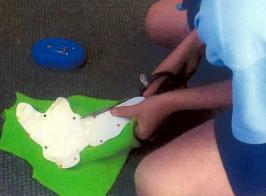
Fabric cutting with scissors.
"After working with industry, I know that people don't work on their own but as part of a team, so we were very pushy about students working together and learning to cooperate and work with others they wouldn't usually work with."
These groups were asked to choose a Māori traditional story from a selection of books and journals and "transform it to life on the big screen". Kim explains that providing enough appropriate reading resources for this section of the unit provided the biggest challenge in terms of pre-planning.
The students broke up into the separate areas of learning that constitutes the unit. Each area has a similar structure, with revision, practice, and student reflection all incorporated within the unit plan and often linked to the enduring understandings within the overall school local curriculum.
To ensure that students could move to different aspects of the project as time and resources became available, the technology team encourages a non-linear approach, which also puts added responsibility into the hands of the students.
Designing and developing a materials outcome
Within textiles materials, the students were first taught some of the basics of sewing machines, their history, and cultural impacts. Students completed a sewing sample to make sure their skills are up to standard. The students moved onto planning, where their chosen puppet character was confirmed and aspects such as the size, shape, colour, and how the electronic circuit would be integrated were determined before construction on the final puppet began.
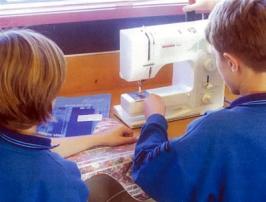
Kids using sewing machine.
For the electronics, the initial lesson revised component recognition and circuit construction using the Electroflash kits. These kits were used for a component of the puppets. The following lessons revised safe soldering techniques. Students were encouraged to consider the implications of inserting the circuit into the hand puppet, taking into account battery access, switch placement, aesthetics, and safety concerns.
Designing and developing a digital outcome
This part of the unit gave the students the opportunity to first practice storyboarding, correct camera usage, and shot composition. They completed a 15-minute filming activity, using the human foot as a story focus,. This was downloaded to the computer to practise editing the footage. The students practised sound composition by creating a soundtrack for their film with an audio software program.
Once the puppets were sewn and the electronic component in place, the individual members of the teams got together to do the storyboarding. The next step was to film their final videos.
While Kim felt that the unit ran fairly smoothly throughout, she explains that problems arose when the students began the editing process towards the end of the project.
"One of our biggest challenges was pressure on the digital media room because we always end up with many groups finishing and needing it at the same time."
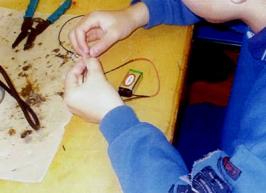
Using needle and thread.
The final videos produced show each group's unique spin on their chosen stories and, most importantly, showcase the range of new skills that the students picked up over the course of the unit as well as their fundamental understanding of the transformation concept.
"I couldn't even count the number of skills students gained and, from this, they really understand transforming and changing things and that technology changes over time – you know, all the concepts we are trying really hard to get them to understand."
Developing trust with parents
Kim reports that the response to the students' videos and the skills they took away from the unit was extremely positive. This reflected a trust that has developed over time between parents and the school with the integration of new curriculum ideas into student work.
"It used to be that parents thought that every child had to take something home, but now they're quite happy if the outcome is digital or simply new skills learned."

